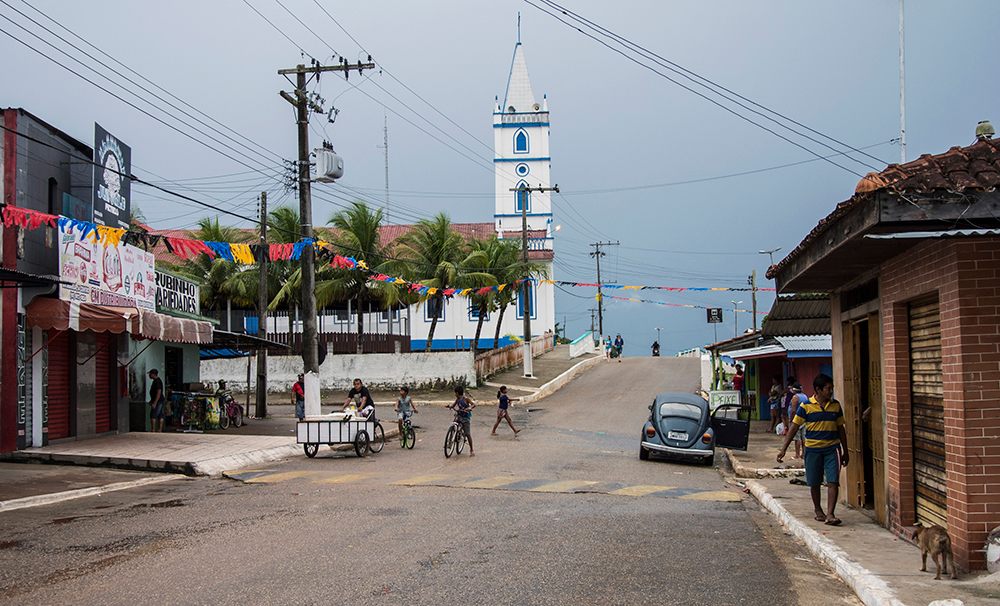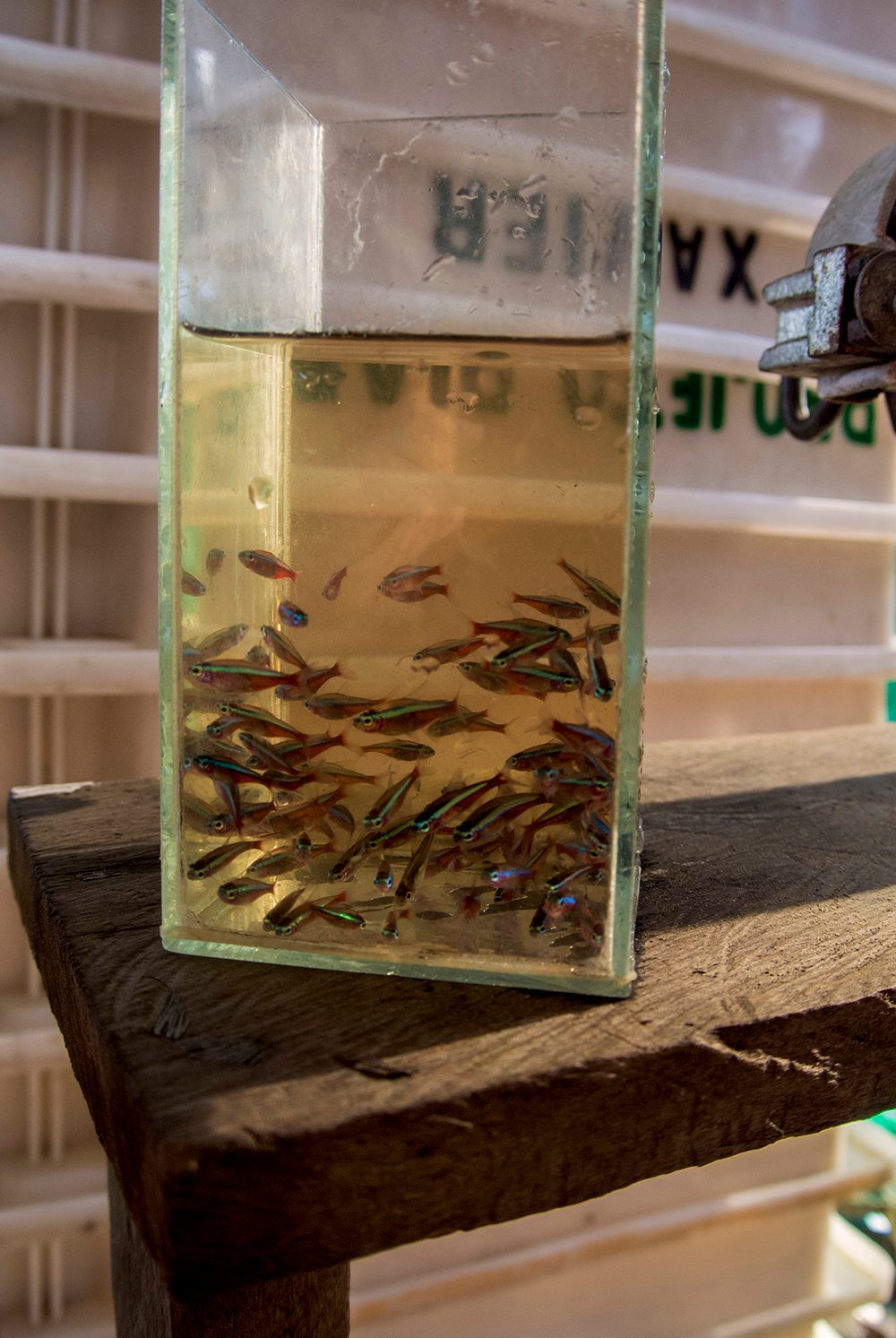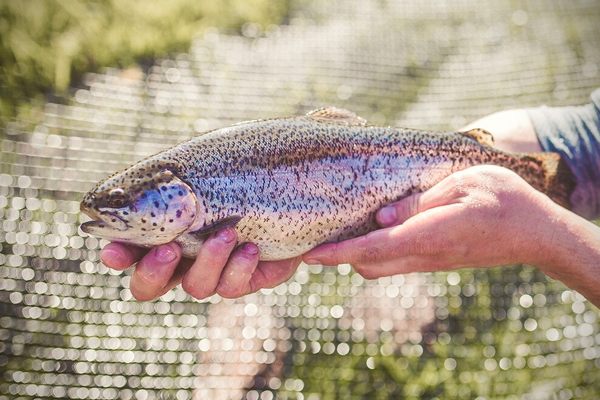The Tiny Amazonian City That Supplies Aquarium Fish to the World
Once a rubber boomtown, remote Barcelos is now at the center of the tropical fish trade.
Deep in Brazil’s Amazon rainforest, the tiny city of Barcelos stands as a slowly crumbling monument to the country’s colonial past and centuries of hard-fought struggle against the encroaching jungle. Two days by boat from Manaus, the nearest big city, Barcelos lies along the banks of the Rio Negro, one of the Amazon’s largest tributaries.
But what sets this city apart from countless other small jungle outposts in the Amazon basin is that Barcelos has, for the past 50 years or more, been the epicenter of a unique trade—harvesting millions of colorful tropical fish destined not for the local food markets but for home aquariums the world over.
 Barcelos’ waterfront—the city can only be reached by boat or sporadic flights from Manaus.
Barcelos’ waterfront—the city can only be reached by boat or sporadic flights from Manaus.Barcelos, with a population of around 30,000 people, is close to the geographic center of the Amazon, and like many other cities in the region it has a long and bloody history. Originally a settlement of Manaus Indians, it became part of the Portuguese push into the interior of Brazil in the 18th century, when it was established as the capital city of what would become the state of Amazonas.
It remained a quiet colonial outpost until the late 1800s, when global interest in the jungle’s native rubber trees turned Barcelos into a center of the “rubber boom,” during which vast fortunes were made off the suffering and enslavement of millions in the Amazon Basin, as businesses in the rapidly industrializing U.S. and Europe clamored for the sticky latex of the rubber tree.
 The city has weathered many hardships in its nearly 300-year history, but the decline of the aquarium fish trade has both locals and outside observers worried for its future.
The city has weathered many hardships in its nearly 300-year history, but the decline of the aquarium fish trade has both locals and outside observers worried for its future.The city today still retains traces of this past, but faded 19th-century buildings have given way to generic concrete storefronts and municipal buildings along the few dusty blocks that qualify as Barcelos’ “downtown.” After the Amazonian rubber trade—which was based on tapping wild rubber trees within the forest—collapsed due to competition from more efficient plantations in Asia, Barcelos sank into quiet recession, and became a backwater once again.
It was only the discovery of a brightly colored fish in 1956 that gave the town its second—and much more benign—boom, and Barcelos once again found itself a transit hub for a valuable commodity.
 Freshly-collected Cardinal Tetras in the region’s characteristic “black” water. These fish will likely end up in pet shops and home aquariums in Europe or the US.
Freshly-collected Cardinal Tetras in the region’s characteristic “black” water. These fish will likely end up in pet shops and home aquariums in Europe or the US.This fish—the cardinal tetra, known to scientists as Paracheirodon axelrodi—is a small, beautiful schooling species with a deep red body adorned with a fluorescent blue stripe. Among the most colorful of all freshwater species, cardinals are some of the most popular fish sold for home aquariums, for which they make ideal residents. For decades, nearly all the cardinal tetras in aquariums around the world would have first passed through Barcelos en route to being shipped, by air cargo, to importers in the U.S., Europe, or Japan.
The discovery and subsequent popularity of the cardinal tetra led to the development of a major industry in Barcelos during the 1960s and ‘70s. Thousands of families in the city and municipality of Barcelos were employed in collecting these fish, a task that evolved into a bona fide occupation in the region; the fishermen and women who specialize in catching tiny aquarium fish became known as piabeiros.
 A bicycle-mounted fish seller makes a sale. Live fish for aquariums are generally worth much more than food fish on the local market.
A bicycle-mounted fish seller makes a sale. Live fish for aquariums are generally worth much more than food fish on the local market.In town, several families are employed as patrons, who front fuel and supplies to fishing families further upriver, and arrange transport and sale of their live haul, in a variation of the elaborate aviamento trade system originally used by rubber traders over 100 years earlier.
Just across the river from the city’s main street, several small transfer stations hold fish in plastic trays, consolidating the fish from dozens of fishing villages before shipping them by ferry to Manaus, a remote metropolis 250 miles down the Rio Negro, so named for its acidic “black” waters. Barcelos relies heavily on this trade, with some researchers estimating that 60 percent of cash incomes in the region derive from tropical fish collecting, sale, and transport.
 ‘Hotel Ornamental’, one of only a few lodgings in town, is owned by a retired aquarium fish trader.
‘Hotel Ornamental’, one of only a few lodgings in town, is owned by a retired aquarium fish trader.The impact of this trade can be felt and seen almost everywhere in Barcelos. In the main square, overlooking the river, a statue of Christ, arms outstretched, is adorned with painted cardinal tetras and discus, another popular aquarium fish. The Hotel Ornamental, one of the few small hotels in town, alludes to the “ornamental” fish business (another name for aquarium fish) and is owned by a retired fish trader.
 Barcelos’ ornamental fish festival is held each year to celebrate the importance of the aquarium fish trade. Two teams, representing Cardinal Tetras and Discus (another popular species) compete for the crown with elaborate dances.
Barcelos’ ornamental fish festival is held each year to celebrate the importance of the aquarium fish trade. Two teams, representing Cardinal Tetras and Discus (another popular species) compete for the crown with elaborate dances.But the most tangible effect this trade has had on the city is undoubtedly the raucous annual festival held in honor of—what else—aquarium fish. This carnival-style festival, complete with hours-long choreographed dance competitions and elaborate floats, is the cultural event of the year in Barcelos, with people from outlying communities flocking to the city for the days-long party.
 A statue of Christ in the town’s main square atop an image of Barcelos’ main commodity—tropical fish.
A statue of Christ in the town’s main square atop an image of Barcelos’ main commodity—tropical fish.By the 1990s, 10 million or more cardinal tetras were being exported annually from Manaus, most having come through Barcelos on their way to tropical fish distributors, neighborhood pet shops, and, ultimately, home aquariums. Despite these seemingly alarming figures, ongoing research indicates that the area’s trade in tetras has had a minimal impact overall on populations of the fish due to their unique reproductive cycle. Each year, as the Amazon basin floods, mature cardinal tetras produce huge numbers of offspring which grow quickly in the food-rich environment of the flooded forests.
As the floodwaters recede, only a small portion of these tetras will make their way back to the main river channel—most are destined to die as they get caught in drying swamps and puddles. The Piabeiros, who can only effectively collect fish during the dry season, harvest from these remnant populations, which would otherwise be doomed to die from lack of oxygen or predation from birds.
 Barcelos continues to serve as a transport hub linking remote villages upriver to the city of Manaus.
Barcelos continues to serve as a transport hub linking remote villages upriver to the city of Manaus.The trade is “not only sustainable, but results in a net benefit for both the people of the region and the environment,” says Scott Dowd, Senior Aquarist at New England Aquarium and Executive Director of Project Piaba, a nonprofit organization focused on increasing the sustainability of the Amazonian fish trade. (This reporter has also volunteered with Project Piaba).
Because of the economic opportunity the fishery provides, locals are less likely to resort to destructive practices like slash-and-burn agriculture, illegal logging, or gold mining—issues which plague many other areas of the Amazon today. The cash income provided by collecting these tropical fish also provides a strong incentive for fishers to protect the pristine rivers and forests which they rely on for their livelihoods— “a very effective driver of environmental protection,” Dowd explains.
 Just across the river from Barcelos, small transfer stations hold thousands of Cardinal Tetras in these net pens before they are sent to exporters in Manaus.
Just across the river from Barcelos, small transfer stations hold thousands of Cardinal Tetras in these net pens before they are sent to exporters in Manaus.Sadly, the future of this fishery—and the city which relies on it so heavily—is anything but certain. In an uncanny echo of the collapse of the rubber trade, the Barcelos aquarium fishery is in steep decline due to competition from farm-raised cardinal tetras produced in Asia.
Many fishers have already been forced to find other sources of income locally (a difficult prospect) or have migrated towards Manaus in hopes of finding work. A recent spike in sport fishing tourism based in Barcelos also failed to live up to its vaunted potential for the city, as few full-time jobs materialized and several companies have gone under after an initial frenzy of construction and hiring.

The city’s small main street goes quiet during the mid-day heat.
In spite of these challenges, hope remains for the city’s future. Although “all possible efforts are being made to preserve the fishery from the threat of collapse,” says Dowd, it is unclear whether Barcelos’ ties to the aquarium trade will remain a central fact of life for the locals for years to come, or whether the colorful fish paintings dotting the town will fade away, much like the crumbling monuments to Portuguese rule and the rubber trade already have.
The older fishers worry, of course, about the fate of their children, but maintain a cautious hope that their longtime source of livelihood—the colorful piabas of the Rio Negro—will continue to sustain them. Like the annual rise and fall of the Amazon, life along the river has always ebbed and flowed, and the people of Barcelos have weathered booms and busts, privation and hard times.











Follow us on Twitter to get the latest on the world's hidden wonders.
Like us on Facebook to get the latest on the world's hidden wonders.
Follow us on Twitter Like us on Facebook